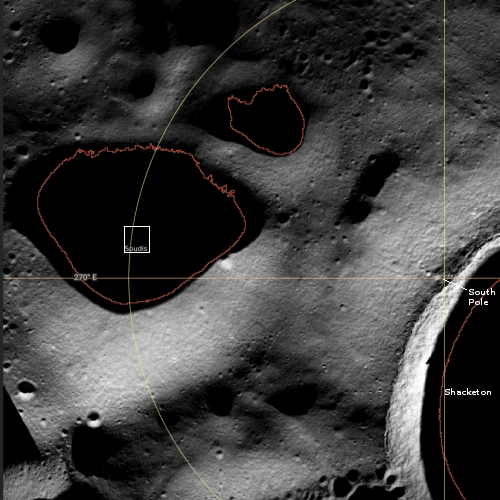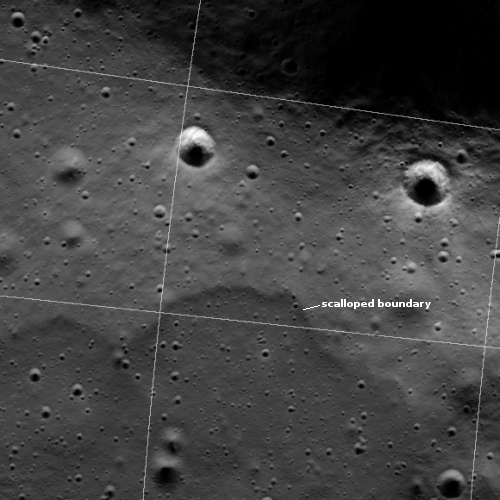Shadowcam on South Korea’s Danuri lunar orbiter sees no obvious ice in the permanently shadowed interior of Spudis crater

Using Shadowcam, a camera built by Arizona State University that is on South Korea’s Danuri lunar orbiter and is designed to see into very dark regions of little light, scientists have obtained optical images showing the permanently shadowed interior of Spudis Crater, located only about ten miles from the Moon’s south pole.
That picture is below. To the left is an annotated overview created from Lunar Reconnaissance Orbiter (LRO) high resolution images. The white box inside Spudis Crater indicates the area covered by the section of the Shadowcam image I have focused on. The red outlines indicate areas that are thought to be permanently shadowed. The relatively flat ridgeline between Shackleton and Spudis is one of the prime future landing sites for NASA’s Artemis program.
From the caption:
The scalloped boundary likely formed when a landslide reached the bottom of the east wall and stopped abruptly against a large debris pile. Alternatively, rather than a landslide, the deposit formed as impact melt flowed down the east crater wall.
The text of the caption is especially interesting in what it does not say. It makes no mention of any visible evidence of ice. Nor does any appear obvious in this Shadowcam picture. These results match earlier Shadowcam images of the interiors of the craters Shacketon and Marvin (just to the left of Spudis outside of view).
The ice could still be there, impregnated within the regolith on the crater floor. That it is not obvious however suggests accessing it will not be easy should anyone build a manned lunar base at this location. These images suggest that the ground will have to be mined very carefully (so that the ice doesn’t sublimate away), than processed to extract that ice.
It is also possible that these images prove that no ice at all exists in these permanently shadowed craters. If so, then a different theory than water-ice will be needed to explain the signature of hydrogen that has been found here.
On Christmas Eve 1968 three Americans became the first humans to visit another world. What they did to celebrate was unexpected and profound, and will be remembered throughout all human history. Genesis: the Story of Apollo 8, Robert Zimmerman's classic history of humanity's first journey to another world, tells that story, and it is now available as both an ebook and an audiobook, both with a foreword by Valerie Anders and a new introduction by Robert Zimmerman.
The print edition can be purchased at Amazon or from any other book seller. If you want an autographed copy the price is $60 for the hardback and $45 for the paperback, plus $8 shipping for each. Go here for purchasing details. The ebook is available everywhere for $5.99 (before discount) at amazon, or direct from my ebook publisher, ebookit. If you buy it from ebookit you don't support the big tech companies and the author gets a bigger cut much sooner.
The audiobook is also available at all these vendors, and is also free with a 30-day trial membership to Audible.
"Not simply about one mission, [Genesis] is also the history of America's quest for the moon... Zimmerman has done a masterful job of tying disparate events together into a solid account of one of America's greatest human triumphs."--San Antonio Express-News

Using Shadowcam, a camera built by Arizona State University that is on South Korea’s Danuri lunar orbiter and is designed to see into very dark regions of little light, scientists have obtained optical images showing the permanently shadowed interior of Spudis Crater, located only about ten miles from the Moon’s south pole.
That picture is below. To the left is an annotated overview created from Lunar Reconnaissance Orbiter (LRO) high resolution images. The white box inside Spudis Crater indicates the area covered by the section of the Shadowcam image I have focused on. The red outlines indicate areas that are thought to be permanently shadowed. The relatively flat ridgeline between Shackleton and Spudis is one of the prime future landing sites for NASA’s Artemis program.
From the caption:
The scalloped boundary likely formed when a landslide reached the bottom of the east wall and stopped abruptly against a large debris pile. Alternatively, rather than a landslide, the deposit formed as impact melt flowed down the east crater wall.
The text of the caption is especially interesting in what it does not say. It makes no mention of any visible evidence of ice. Nor does any appear obvious in this Shadowcam picture. These results match earlier Shadowcam images of the interiors of the craters Shacketon and Marvin (just to the left of Spudis outside of view).
The ice could still be there, impregnated within the regolith on the crater floor. That it is not obvious however suggests accessing it will not be easy should anyone build a manned lunar base at this location. These images suggest that the ground will have to be mined very carefully (so that the ice doesn’t sublimate away), than processed to extract that ice.
It is also possible that these images prove that no ice at all exists in these permanently shadowed craters. If so, then a different theory than water-ice will be needed to explain the signature of hydrogen that has been found here.
On Christmas Eve 1968 three Americans became the first humans to visit another world. What they did to celebrate was unexpected and profound, and will be remembered throughout all human history. Genesis: the Story of Apollo 8, Robert Zimmerman's classic history of humanity's first journey to another world, tells that story, and it is now available as both an ebook and an audiobook, both with a foreword by Valerie Anders and a new introduction by Robert Zimmerman.
The print edition can be purchased at Amazon or from any other book seller. If you want an autographed copy the price is $60 for the hardback and $45 for the paperback, plus $8 shipping for each. Go here for purchasing details. The ebook is available everywhere for $5.99 (before discount) at amazon, or direct from my ebook publisher, ebookit. If you buy it from ebookit you don't support the big tech companies and the author gets a bigger cut much sooner.
The audiobook is also available at all these vendors, and is also free with a 30-day trial membership to Audible.
"Not simply about one mission, [Genesis] is also the history of America's quest for the moon... Zimmerman has done a masterful job of tying disparate events together into a solid account of one of America's greatest human triumphs."--San Antonio Express-News



Can I be the first to say it out loud? There is NO ICE in the shadows of the craters on the Moon! None at all! We need to rethink how future bases will get water, perhaps by importing it. The dream is over!
David M. Cook: Though I have always agreed that no ice has always been a very strong possibility, and have written about this possibility numerous times (unlike all other press outlets), it is still not a certain finding.
What the Shadowcam images tell us, at a minimum, is that getting water at the South Pole of the Moon is not going to be simple, and maybe impractical. This is a major finding, regardless.
“If so, then a different theory than water-ice will be needed to explain the signature of hydrogen that has been found here.”
Hydrocarbons. Like the black tarry stuff on comets. Even better then water as you get carbon. Plenty of oxygen in lunar rocks.
The ice is likely present as an intimate mixture with the regolith rather than as discrete chunks of ice.
Bill Farrand: Yes, being intermixed in the regolith is certainly a possibility, as I mention in the post. However, much of the push to go the south pole has been based on the hope of the relatively easy availability of water ice. Discrete chunks of ice were often postulated.
These pictures appear to eliminate that possibility. Water will not be easy to get, at all, even if it is there. The processing will be complex, with involved engineering in the crater, so that the water in the regolith doesn’t sublimate away by exposure to sunlight.
If so, these images are a major finding.